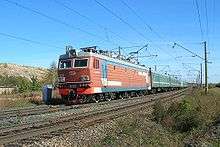Bo-Bo-Bo

A Bo-Bo-Bo or Bo'Bo'Bo' in UIC classification is a locomotive with three independent two-axle bogies with all axles powered by separate traction motors. In the AAR system, this is simplified to B-B-B.
The Bo-Bo-Bo configuration is often used to lower axle weight while keeping lateral forces low compared to a locomotive with two three-axle bogies, thus allowing the locomotive to use lightly laid track, in particular narrow-gauge railways.
The arrangement is extensively used on Italian and Japanese railways. Other examples include New Zealand's DJ, EW and EF classes; the Eurotunnel Class 9 locomotives, which were themselves derived from the New Zealand EF class; the Swiss SBB Re 6/6 (Re 620); the Russia Railways EP10, and the South Korean Korail Class 8000. China imported 6K electric locomotive from Japan between 1986 and 1987. The Bo-Bo-Bo design was applied to SS7 series except SS7E.
This wheel arrangement requires either an articulated frame (becoming a Bo+Bo+Bo arrangement) or else significant side play on the center bogie. The Italian locomotives and New Zealand EW class are articulated, whereas the Eurotunnel and New Zealand EF and DJ class locomotives' central bogies have a lot of sideplay.
B'B'B' locomotives
A similar arrangement, but without separate traction motors for each axle, would be a B'B'B' arrangement as UIC, indistinguishably B-B-B in AAR.
This arrangement has been used for electric locos with three monomotor bogies, such as the Italian FS Class E.632 of 1982.
See also
- B+B+B
- Bo-Bo
- Bo-Bo-Bo locomotives
- Co-Co locomotives
